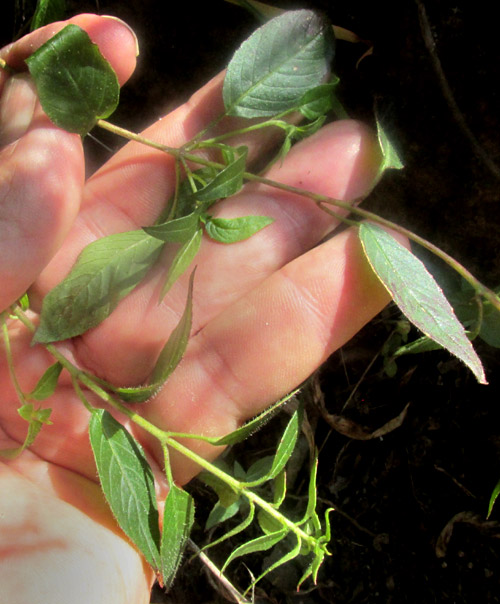Excerpts from Jim Conrad's
Naturalist Newsletter
Entry dated November 7, 2023, from notes taken at Cascadas de La Piedad waterfall 3kms NW of the community of San Pablo, municipality of Almeaco de Bonfil; bedrock of igneous andesite; N20.1003°, W100.0026°, elevation 2360 meters (7750ft); extreme southern Querétaro state, MÉXICO
LOPEZIA MINIATA

On a steep slope of a narrow, moist, usually shaded, erosional gully about 300m northeast of the Cascada de La Piedad, or Piety Waterfall, at the base of an andesite rock, the above wildflower leaned into a narrow beam of sunlight. Its slender stems bore one simple leaf per node.

Though the vegetative part didn't look anything like an orchid, the flower looked as strangely complex and pretty as an orchid flower. I'd seen a similar but slightly different blossom, on Lopezia racemosa, so this was another Lopezia species, a member of the Evening Primrose Family, the Onagraceae, famous for its elegant flowers.
I knew that above we're seeing a blossom with four sepals, four dissimilar petals and two dissimilar stamens. Still, it can be hard to recognize individual parts. The four petals are the relatively wide, paler pink items occupying most of the picture's top half. The two petals between the broadly spreading outer ones each bear two white, teardrop-shaped glands midway their lengths; the outer petals bear no such glands. Note the glistening droplets below each gland. Presumably they're nectar.
The two stamens look like a single one in the picture, for one is a sterile staminode, which lies below the fertile stamen. In the picture, they appear immediately above the slender, darker-pink sepal pointing exactly downward.
This stamen-holding-a-stamen assembly is something extraordinary. Peter Raven in his 1979 paper entitled "A survey of reproductive biology in Onagraceae," writing about Lopezia flowers, says that "... the fertile stamen is enfolded by the spoon-shaped sterile stamen and held under tension, discharging its pollen explosively on the lower side of insects visiting the flower."

Above, the stamen assembly can be seen as a white filament tipped with a brown anther, with the filament resting atop the pink staminode. Atop the flower's slender pedicel, notice the spherical ovary, which is typical of Lopezia. Since sepals, petals and anthers arise above the ovary, not below, this is an inferior ovary, obligatory for the entire Evening Primrose Family. Note how everything except the flower is covered with short, gland-tipped hairs. Here's a better look at leaf shape and venation:
,
Currently, the GBIF database reports 42 Lopezia species, all Mexican and Central American, though some have become invasive elsewhere, and sometimes are planted in gardens. The Flora del Bajío documents three Lopezia species occurring in the upland, central Mexican state of Querétaro. Our plant, distinguished by its hairy vegetative parts and with each gland-bearing petal having two glands, not just one, shows itself to be LOPEZIA MINIATA. Though the species occurs in no English speaking country, in English Lopezia species often are referred to as Mosquito Flowers.
Lopezia miniata occurs throughout most of Mexico's uplands from the northwestern states south to Panama. It's described as occupying temperate mountain forests and disturbed scrub. Though several sources report the very similar Lopezia racemosa as useful in traditional Mexican medicine, and even that pigs and burros eat it, I find nothing of that nature about our Lopezia miniata. That's hard to explain since they're so similar looking. I suspect our present Lopezia is used like others.